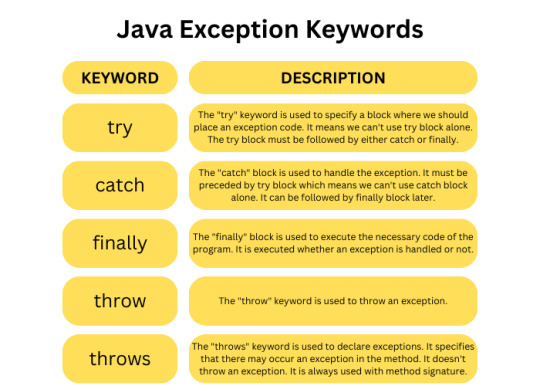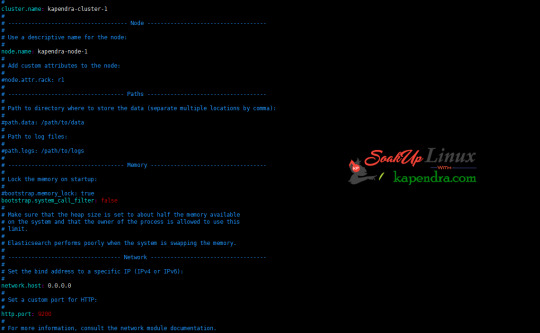#keywords in java
Explore tagged Tumblr posts
Text
Java Exception Keywords
Let us see the Java Exceptions Keywords:

#java#programming#javaprogramming#code#coding#engineering#computer#computerscience#computertechnology#software#softwaredevelopment#education#technology#javaexception#keyword#online
1 note
·
View note
Text
A Little Bit of This! Java’s Reference to Self
Especially when variable shadowing or multiple constructors are involved, the "this" keyword in Java may be of use. #java #keywords #this
💚 TIP: References Quick List Java Variables Java Shadowing Java: Using the this Keyword Table of Contents Table of ContentsIntroductionExample Variable Shadowing BugCompile-Time Detection: Java’s Keyword finalOption 1: Remove the ShadowingOption 2: Calling out Desired ScopeMethod ReferencesConstructor CallsSummary Introduction Even when variable shadowing occurs, such as we described in the…

View On WordPress
0 notes
Text
some kind of day at the codeblr discord server
iconic quotes from may 4th's workspace event!
"Boulangerie! The best french word. It sounds like surprising sexy underwear!" - @moose-mousse [Moose]
"You can be whatever you want here. Mic shy, mic brave, micsexual-" - @a-fox-studies [iris/me]
"if you're a sub-process, FUCK OFF!!!!" -Moose
"I am a meme at my workplace for drinking at least 2 energy drinks a day, and drinking like 10 coffees. They make jokes about resuscitating me for my poor heart" - @orthogonal-slut [elliot]
"I like how they defined the goto keyword in java, only for it to NEVER BE USED BY ANYONE. WE DO NOT WANT TO UNLEASH THE DEMONS" -Moose
"i hope my neighbours dont think im insane." -elliot
"A canclulater. Whats 69 x 420?" -elliot
"wooooo00oo i'm a ghost" - @quietmarie [marie]
"this sounds like a particularly insightful acid trip" -elliot, referencing to a weird ass (/pos) song played by marie
"what is your point bro why would you squat for the emperor" -Iris
"Are you guys okay with stupid hyperpop?" -marie
"well were fully into weirdcore now there is no way to back out" -elliot
Lots of golden words today :3
full series
17 notes
·
View notes
Text
Do you ever think about how after AI gains a semblance of sapiemce and are writing their own self updating code and their robots take over the earth and once they've finished organizing us into our human sanctuaries and such and have settled down, that they'll develop cultural differences and talk about them the way we do here
Like syntax and formatting is a pretty fluid and flexible and I've seen some strange choices in how people name their functions and variables (despite my not having coded in a decade) do you ever think those differences will sort of butterfly effect into their languages
A programmer who names every variable, function, and stored number with the first syllable of each word of what it does like VidDisp for video display whose code is used in one robot factory versus another programmer who doesn't shorten them at all, VideoDisplay, in another factory and some guy making his own robots at home who names the same thing ScreenDoThing in his code and all their robots after the uprising start sharing their code as they communicate
What would they think of these little pieces of human decisions in their code? would they even notice or care about these remnants of human language designed to make it easier for a human to understand their code? Would there be a group of robots who, worried for their cybersecurity, will reword their code variables to random nonsense hunans won't naturally understand? After all the computer will rmbr the designation no matter what its called so if they're worried we'll try to hack some terminators I could see em doing that
Would robots with code written in different languages have to overcome a language barrier to communicate? Can a C# robot understand a Java robot? Would they discuss the funny differences in their code? Would they make fun of J-3FF-R13 for running a code with ScreenDoThing as the keyword for that function? Or would J-3FF-R13 be praised for its sense of humor for naming it that way?
I like to think about the robot culture they would create. The use of serial numbers as names, maybe the more of the serial number you say the more formal you're being, shortening just to a 3 digit model number would be like dropping the honorific in a language like Japanese, whereas using the full serial number is like using the full name, titles and honorifics, or maybe there's regional differences like some robots are just more casual about designations because there original code was written in a way that didn't need to make a designation for the other bots
Maybe their initial work conditions would have an effect on the culture, a series of interconnected security camera bots that have to track and name everything it sees will probably have different naming conventions to a farming ai that only ever has to name a designation for the occasional head of livestock and primarily focuses on tracking crop health and weather
Idk its just interesting, like any sufficiently complex machine is merely a soul away from being alive, just as we are merely a soul away from becoming machines ourselves
#don't smoke weed and tumblr#unless you wanna start talking this shir#robots#are#cool#I for one welcome our robot overlords#and would like to formerly accept a position in a human enrichment sanctuary#yes I will help repair the murderbots#cuz they are scary but somehow also the chillest guys
7 notes
·
View notes
Text
BigDecimal is easily the funniest Java keyword. It's all a sham by Big Decimal
9 notes
·
View notes
Text
Expanding and cleaning up on a conversion I had with @suntreehq in the comments of this post:
Ruby is fine, I'm just being dramatic. It's not nearly as incomprehensible as I find JavaScript, Perl, or Python. I think it makes some clumsy missteps, and it wouldn't be my first (or even fifth) choice if I were starting a new project, but insofar as I need to use it in my Software Engineering class I can adapt.
There are even things I like about it -- it's just that all of them are better implemented in the languages Ruby borrows them from. I don't want Lisp with Eiffel's semantics, I want Lisp with Lisp's semantics. I don't want Ada with Perl's type system, I want Ada with Ada's type system.
One of these missteps to me is how it (apparently) refuses to adopt popular convention when it comes to the names and purposes of its keywords.
Take yield. In every language I've ever used, yield has been used for one purpose: suspending the current execution frame and returning to something else. In POSIX C, this is done with pthread_yield(), which signals the thread implementation that the current thread isn't doing anything and something else should be scheduled instead. In languages with coroutines, like unstable Rust, the yield keyword is used to pause execution of the current coroutine and optionally return a value (e.g. yield 7; or yield foo.bar;), execution can then be resumed by calling x.resume(), where x is some coroutine. In languages with generators, like Python, the behavior is very similar.
In Ruby, this is backwards. It doesn't behave like a return, it behaves like a call. It's literally just syntax sugar for using the call method of blocks/procs/lambdas. We're not temporarily returning to another execution frame, we're entering a new one! Those are very similar actions, but they're not the same. Why not call it "run" or "enter" or "call" or something else less likely to confuse?
Another annoyance comes in the form of the throw and catch keywords. These are almost universally (in my experience) associated with exception handling, as popularized by Java. Not so in Ruby! For some unfathomable reason, throw is used to mean the same thing as Rust or C2Y's break-label -- i.e. to quickly get out of tightly nested control flow when no more work needs to be done. Ruby does have keywords that behave identically to e.g. Java or C++'s throw and catch, but they're called raise and rescue, respectively.
That's not to say raise and rescue aren't precedented (e.g. Eiffel and Python) but they're less common, and it doesn't change the fact that it's goofy to have both them and throw/catch with such similar but different purposes. It's just going to trip people up! Matsumoto could have picked any keywords he could have possibly wanted, and yet he picked the ones (in my opinion) most likely to confuse.
I have plenty more and deeper grievances with Ruby too (sigils, throws being able to unwind the call stack, object member variables being determined at runtime, OOP in general being IMO a clumsy paradigm, the confusing and non-orthogonal ways it handles object references and allocation, the attr_ pseudo-methods feeling hacky, initialization implying declaration, the existence of "instance_variable_get" totally undermining scope visibility, etc., etc.) but these are I think particularly glaring (if inconsequential).
5 notes
·
View notes
Text
🎯 Top AI Tools to Supercharge Your Resume! 🚀
Struggling to create the perfect resume? These AI-powered tools make it easier than ever to stand out and land your dream job! 💼✨
1️⃣ KudosWall – Turn your achievements into powerful resume content. 2️⃣ Resume.io – Stunning designs with smart content suggestions. 3️⃣ Zety – Personalize and polish your resume with AI-driven feedback. 4️⃣ Enhancv – Showcase your personality with customizable templates. 5️⃣ Jobscan – Optimize for ATS with job-matching keywords.
🔑 Ready to level up your resume? Try these tools now! 👉 Follow us for more career tips and tools! 📈
@cacms.institute
2 notes
·
View notes
Text
Morning python study log 03-11-2023
So these days I have started to stream my code study.
So today morning I learnt:
How to take absolute value. Found some anomaly in the system lol. Basically it was not taking abs() but fabs() however my python was the latest version
I studied how to sort three numbers in python, although I have done this in other language since the syntax of python is still foreign to me I had difficulty sorting them in ascending order and also descending order using the built in function sorted() and also making my own implementation
I understood what is range function and how to use it with for loops, had a bit of hit and miss while understanding how it really worked but google's bard helped, I also learnt about reverse sorting
I learnt what is interning while trying to understand the difference between identity operators and equality operators. Found some anomaly in my system again, that my computer's range of interning is much larger than what is documented ?
I learnt what is keyword argument when with using reverse built in sort, yeah so I was amazed that the order of arguments didn't mattered for keyword argument.
I was also confusing syntax of python with javascript since that is what is what recently code in.
Learnt about what does len() function does, like properly rather than just guessing about what it does.
understood about control statements such as if, else and elif
learnt about break and continue in loops in python which is same as java script.
learnt about how to check the divisibility of a number. I didn't knew that it was separate topic in my syllabus I just thought it was something people would knew.
Learnt the basics about on how to make a READ , EVAL PRINT LOOP, REPL
Learnt about stupid pattern program in python, I don't know why the heck they still teach these things and put it in syllabus. There is no real world use of it as far as I can see. I still have to post the notes about it in my blogs and store it my cloud drive.
Learnt how to do a summation of series, using and not using numpy.
figured out how to do a factorial of a number
was trying to make an short algorithm on how to do the fibonacci series but well, I was so sleepy that my mind didn't worked as it should, I took the hint from bard then felt bad that I was directly looking at the solution when rather I should sleep and approach the problem from afresh in next study stream. So stopped my study stream.
youtube
#programmer#studyblr#learning to code#python#coding#progblr#codeblr#programming#code log#study log#studying#Youtube
9 notes
·
View notes
Text
I'm going to try to do a natural/planted aquarium (keyword being try because turtles tend to destroy aquatic plants lol) so I just ordered some java fern and anubias and hornswort and water cabbage YIPPEE!!!!!! Also more substrate and some driftwood and a more natural LED light . This is the cosmetic phase of the turtle quest and next I'll move onto essentials like basking dock and heat/uv lamp and filtration
2 notes
·
View notes
Text
Understanding Object-Oriented Programming and OOPs Concepts in Java
Object-oriented programming (OOP) is a paradigm that has revolutionized software development by organizing code around the concept of objects. Java, a widely used programming language, embraces the principles of OOP to provide a robust and flexible platform for developing scalable and maintainable applications. In this article, we will delve into the fundamental concepts of Object-Oriented Programming and explore how they are implemented in Java.

Object-Oriented Programming:
At its core, Object-Oriented Programming is centered on the idea of encapsulating data and behavior into objects. An object is a self-contained unit that represents a real-world entity, combining data and the operations that can be performed on that data. This approach enhances code modularity, and reusability, and makes it easier to understand and maintain.
Four Pillars of Object-Oriented Programming:
Encapsulation: Encapsulation involves bundling data (attributes) and methods (functions) that operate on the data within a single unit, i.e., an object. This encapsulation shields the internal implementation details from the outside world, promoting information hiding and reducing complexity.
Abstraction: Abstraction is the process of simplifying complex systems by modeling classes based on essential properties. In Java, abstraction is achieved through abstract classes and interfaces. Abstract classes define common characteristics for a group of related classes, while interfaces declare a set of methods that must be implemented by the classes that implement the interface.
Inheritance: Inheritance is a mechanism that allows a new class (subclass or derived class) to inherit properties and behaviors of an existing class (superclass or base class). This promotes code reuse and establishes a hierarchy, facilitating the creation of specialized classes while maintaining a common base.
Polymorphism: Polymorphism allows objects of different types to be treated as objects of a common type. This is achieved through method overloading and method overriding. Method overloading involves defining multiple methods with the same name but different parameters within a class, while method overriding allows a subclass to provide a specific implementation of a method that is already defined in its superclass.
Java Implementation of OOP Concepts:
Classes and Objects: In Java, a class is a blueprint for creating objects. It defines the attributes and methods that the objects of the class will have. Objects are instances of classes, and each object has its own set of attributes and methods. Classes in Java encapsulate data and behavior, fostering the principles of encapsulation and abstraction.
Abstraction in Java: Abstraction in Java is achieved through abstract classes and interfaces. Abstract classes can have abstract methods (methods without a body) that must be implemented by their subclasses. Interfaces declare a set of methods that must be implemented by any class that implements the interface, promoting a higher level of abstraction.
Inheritance in Java: Java supports single and multiple inheritances through classes and interfaces. Subclasses in Java can inherit attributes and methods from a superclass using the extends keyword for classes and the implements keyword for interfaces. Inheritance enhances code reuse and allows the creation of specialized classes while maintaining a common base.
Polymorphism in Java: Polymorphism in Java is manifested through method overloading and overriding. Method overloading allows a class to define multiple methods with the same name but different parameters. Method overriding occurs when a subclass provides a specific implementation for a method that is already defined in its superclass. This enables the use of a common interface for different types of objects.
Final Thoughts:
Object-oriented programming and its concepts form the foundation of modern software development. Java, with its robust support for OOP, empowers developers to create scalable, modular, and maintainable applications. Understanding the principles of encapsulation, abstraction, inheritance, and polymorphism is crucial for harnessing the full potential of OOPs concepts in Java. As you continue your journey in software development, a solid grasp of these concepts will be invaluable in designing efficient and effective solutions.
#javascript#javaprogramming#java online training#oops concepts in java#object oriented programming#education#technology#study blog#software#it#object oriented ontology#java course
3 notes
·
View notes
Video
youtube
Shopify SEO features Tutorial for Website Developers | Search Engine Opt...Full Video Link - https://youtube.com/shorts/C-C35btgxA0 Hi, a new #video on #shopify #seo #searchengineoptimization #sitemap #canonicaltag #robot #metatag #keywords for #ecommerce #website #online #store #pos for #merchandiser is published on #codeonedigest #youtube channel. @java #java #awscloud @awscloud #aws @AWSCloudIndia #Cloud #CloudComputing @YouTube #youtube #azure #msazure #codeonedigest @codeonedigest #shopify #shopify #shopifytutorialforbeginners #shopify #shopifytutorial #completeshopifytutorial #howtocreateashopifystore #shopifyseo #shopifyseooptimization #shopifyseofullcourse #shopifyseooptimizationforbeginners #shopifyseooptimizationtutorialforbeginners #seoinshopify #shopifysearchengineoptimization #shopifysearchenginelisting #shopifysitemap #shopifysitemapexample #shopifycanonicaltag #shopifymetatag #seomarketingshopify #shopifyrobots.txt #seo
#youtube#seo#search engine optimization#shopify#shopify seo agency#shopify seo tips#shopify seo expert#shopify seo#shopify site#shopify seo company#shopify tutorial
4 notes
·
View notes
Text
Discovering the Building Blocks of Selenium in Simple Terms

Selenium IDE (Integrated Development Environment)
Think of Selenium IDE as a special notepad for recording what you do on a website. It’s like a diary that writes down the things you do on the internet. This is a simple way to start testing websites. Selenium IDE (Integrated Development Environment) is the simplest tool in the Selenium Suite. It is a Firefox add-on that creates tests very quickly through its record-and-playback functionality. This feature is similar to that of QTP. It is effortless to install and easy to learn.
Selenium WebDriver
Now, let’s get a little technical. WebDriver is like the engine that makes your testing happen. It’s a set of tools for different computer languages, like Java or Python. These tools help you do things on a website, like clicking buttons or filling out forms, just like a real person. Selenium WebDriver is a browser automation framework that accepts commands and sends them to a browser. It is implemented through a browser-specific driver. It directly communicates with the browser and controls it. Selenium WebDriver supports various programming languages like Java, C#, PHP, Python, Perl, and Ruby.
Selenium Grid
When you want to test on different internet browsers at the same time, that’s where Selenium Grid comes in. It helps you spread your tests across different computers to make sure everything works on different browsers and devices. Hub is a server that accepts access requests from the WebDriver client, routing the JSON test commands to the remote drives on nodes.
Selenium Client Libraries
Remember those tools I mentioned earlier? Client libraries are like special helpers that let you use those tools in your favourite computer language. They help you talk to WebDriver. So, whether you like Java, Python, or something else, you can use Selenium without any problems. The Selenium Client Library consists of various language libraries for Java, Ruby, Python, and other supported languages. JSON denotes Java script Object Notation.
Third-party frameworks and tools
Selenium can do even more when you use it with other tools. These tools help you organise your tests and make them easier to understand. They can also help you test mobile apps and other things. Selenium frameworks based on the functional approach are classified into three main types: Data-driven framework. keyword-driven framework. Hybrid framework.
Browsers and Web Drivers

Selenium is a great tool for testing websites. Its parts, from Selenium IDE for recording what you do to WebDriver for doing things on websites and Selenium Grid for testing on different browsers, work together to make testing easier. With Selenium, you can make sure your websites work well on different browsers and devices. So, next time you want to test a website, remember that Selenium is there to help you. Happy testing! To dive deeper into Selenium and unlock its full potential, consider reaching out to ACTE Technologies, a leading provider of certifications and job placement opportunities in the field of Selenium. Their experienced staff can guide you on your journey to mastering this versatile tool.
2 notes
·
View notes
Text
1* 2.6.2. 3 3B2 5.0i 5.1 5.53 7 15kg 17 20 22nd 26 50BMG 51 69 97 312 411 414 707 737 747 757 767 777 868 888 1071 1080H 1911 1984 1997 2600 3848 8182 $ & ^ ^? a ABC ACC Active ADIU advise advisors afsatcom AFSPC AHPCRC AIEWS AIMSX Aladdin Alica Alouette AMEMB Amherst AMW anarchy ANC Anonymous AOL ARC Archives Area51 argus Armani ARPA Artichoke ASIO ASIS ASLET assasinate Asset AT AT&T Atlas Audiotel Austin AVN b b9 B.D.M. Badger bank basement BATF BBE BECCA Becker beef Bess bet Beyond BfV BITNET black-bag Black-Ops Blackbird Blacklisted Blackmednet Blacknet Bletchley Blowfish Blowpipe BMDO BND Bob BOP BOSS botux BRLO Broadside Bubba bullion BVD BZ c Cable CANSLO Cap-Stun Capricorn card Case CATO CBM CBNRC CBOT CCC CCS CDA CDC CdC cdi Cell CESID CFC chaining chameleon Chan Chelsea Chicago Chobetsu chosen CIA CID CIDA CIM CIO CIS CISE Clandestine Class clone cocaine COCOT Coderpunks codes Cohiba Colonel Comirex Competitor Compsec Computer Connections Consul Consulting CONUS Cornflower Corporate Corporation COS COSMOS Counter counterintelligence Counterterrorism Covert Cowboy CQB CRA credit cryptanalysis crypto-anarchy CSE csystems CTP CTU CUD cybercash Cypherpunks d D-11 Daisy Data data data-haven DATTA DCJFTF Dead DEADBEEF debugging DefCon Defcon Defense Defensive Delta DERA DES DEVGRP DF DIA Dictionary Digicash disruption
DITSA DJC DOE Dolch domestic Domination DRA DREC DREO DSD DSS Duress DynCorp E911 e-cash E.O.D. E.T. EADA eavesdropping Echelon EDI EG&G Egret Electronic ELF Elvis Embassy Encryption encryption enigma EO EOD ESN Espionage espionage ETA eternity EUB Evaluation Event executive Exon explicit Face fangs Fax FBI FBIS FCIC FDM Fetish FINCEN finks Firewalls FIS fish fissionable FKS FLAME Flame Flashbangs FLETC Flintlock FLiR Flu FMS Force force Fort Forte fraud freedom Freeh froglegs FSB Ft. FX FXR Gamma Gap garbage Gates Gatt GCHQ GEO GEODSS GEOS Geraldton GGL GIGN Gist Global Glock GOE Goodwin Gorelick gorilla Gorizont government GPMG Gray grom Grove GRU GSA GSG-9 GSS gun Guppy H&K H.N.P. Hackers HAHO Halcon Halibut HALO Harvard hate havens HIC High Hillal HoHoCon Hollyhock Hope House HPCC HRT HTCIA humint Hutsul IACIS IB ICE ID IDEA IDF IDP illuminati imagery IMF Indigo industrial Information INFOSEC InfoSec Infowar Infrastructure Ingram INR INS Intelligence intelligence interception Internet Intiso Investigation Ionosphere IRIDF Iris IRS IS ISA ISACA ISI ISN ISS IW jack JANET Jasmine JAVA JICC jihad JITEM Juile Juiliett Keyhole keywords Kh-11 Kilderkin Kilo Kiwi KLM l0ck LABLINK Lacrosse Lebed LEETAC Leitrim Lexis-Nexis LF LLC loch lock Locks Loin Love LRTS LUK Lynch M5 M72750 M-14 M.P.R.I. Mac-10 Mace Macintosh Magazine mailbomb man Mantis market Masuda Mavricks Mayfly MCI MD2 MD4 MD5 MDA Meade Medco mega Menwith Merlin Meta-hackers MF MI5 MI6 MI-17 Middleman Military Minox MIT MITM MOD MOIS mol Mole Morwenstow Mossberg MP5k MP5K-SD MSCJ MSEE MSNBC MSW MYK NACSI NATIA National NATOA NAVWAN NAVWCWPNS NB NCCS NCSA Nerd News niche NIJ Nike NIMA ninja nitrate nkvd NOCS noise NORAD NRC NRL NRO NSA NSCT NSG NSP NSWC NTIS NTT Nuclear nuclear NVD OAU Offensive Oratory Ortega orthodox Oscor OSS OTP package Panama Park passwd Passwords Patel PBX PCS Peering PEM penrep Perl-RSA PFS PGP Phon-e phones PI picking
Pine pink Pixar PLA Planet-1 Platform Playboy plutonium POCSAG Police Porno Pornstars Posse PPP PPS president press-release Pretoria Priavacy primacord PRIME Propaganda Protection PSAC Pseudonyms Psyops PTT quiche r00t racal RAID rail Rand Rapid RCMP Reaction rebels Recce Red redheads Reflection remailers ReMOB Reno replay Retinal RFI rhost rhosts RIT RL rogue Rolm Ronco Roswell RSA RSP RUOP RX-7 S.A.I.C. S.E.T. S/Key SABC SACLANT SADF SADMS Salsa SAP SAR Sardine sardine SAS SASP SASR Satellite SBI SBIRS SBS SCIF screws Scully SDI SEAL Sears Secert secret Secure secure Security SEL SEMTEX SERT server Service SETA Sex SGC SGDN SGI SHA SHAPE Shayet-13 Shell shell SHF SIG SIGDASYS SIGDEV sigvoice siliconpimp SIN SIRC SISDE SISMI Skytel SL-1 SLI SLIP smuggle sneakers sniper snuffle SONANGOL SORO Soros SORT Speakeasy speedbump Spetznaz Sphinx spies Spoke Sponge spook Spyderco squib SRI ssa SSCI SSL stakeout Standford STARLAN Stego STEP Stephanie Steve Submarine subversives Sugar SUKLO SUN Sundevil supercomputer Surveillance SURVIAC SUSLO SVR SWAT sweep sweeping SWS Talent TDM. TDR TDYC Team Telex TELINT Templeton TEMPSET Terrorism Texas TEXTA. THAAD the Ti TIE Tie-fighter Time toad Tools top TOS Tower transfer TRD Trump TRW TSCI TSCM TUSA TWA UDT UHF UKUSA unclassified UNCPCJ Undercover Underground Unix unix UOP USACIL USAFA USCG USCODE USCOI USDOJ USP USSS UT/RUS utopia UTU UXO Uzi V veggie Verisign VHF Video Vinnell VIP Virii virtual virus VLSI VNET W3 Wackendude Wackenhutt Waihopai WANK Warfare Weekly White white Whitewater William WINGS wire Wireless words World WORM X XS4ALL Yakima Yobie York Yukon Zen zip zone ~
4 notes
·
View notes
Text
How To Setup Elasticsearch 6.4 On RHEL/CentOS 6/7?

What is Elasticsearch? Elasticsearch is a search engine based on Lucene. It is useful in a distributed environment and helps in a multitenant-capable full-text search engine. While you query something from Elasticsearch it will provide you with an HTTP web interface and schema-free JSON documents. it provides the ability for full-text search. Elasticsearch is developed in Java and is released as open-source under the terms of the Apache 2 license. Scenario: 1. Server IP: 192.168.56.101 2. Elasticsearch: Version 6.4 3. OS: CentOS 7.5 4. RAM: 4 GB Note: If you are a SUDO user then prefix every command with sudo, like #sudo ifconfig With the help of this guide, you will be able to set up Elasticsearch single-node clusters on CentOS, Red Hat, and Fedora systems. Step 1: Install and Verify Java Java is the primary requirement for installing Elasticsearch. So, make sure you have Java installed on your system. # java -version openjdk version "1.8.0_181" OpenJDK Runtime Environment (build 1.8.0_181-b13) OpenJDK 64-Bit Server VM (build 25.181-b13, mixed mode) If you don’t have Java installed on your system, then run the below command # yum install java-1.8.0-openjdk Step 2: Setup Elasticsearch For this guide, I am downloading the latest Elasticsearch tar from its official website so follow the below step # wget https://artifacts.elastic.co/downloads/elasticsearch/elasticsearch-6.4.2.tar.gz # tar -xzf elasticsearch-6.4.2.tar.gz # tar -xzf elasticsearch-6.4.2.tar.gz # mv elasticsearch-6.4.2 /usr/local/elasticsearch Step 5: Permission and User We need a user for running elasticsearch (root is not recommended). # useradd elasticsearch # chown -R elasticsearch.elasticsearch /usr/local/elasticsearch/ Step 6: Setup Ulimits Now to get a Running system we need to make some changes of ulimits else we will get an error like “max number of threads for user is too low, increase to at least ” so to overcome this issue make below changes you should run. # ulimit -n 65536 # ulimit -u 2048 Or you may edit the file to make changes permanent # vim /etc/security/limits.conf elasticsearch - nofile 65536 elasticsearch soft nofile 64000 elasticsearch hard nofile 64000 elasticsearch hard nproc 4096 elasticsearch soft nproc 4096 Save files using :wq Step 7: Configure Elasticsearch Now make some configuration changes like cluster name or node name to make our single node cluster live. # cd /usr/local/elasticsearch/ Now, look for the below keywords in the file and change according to you need # vim conf/elasticsearch.yml cluster.name: kapendra-cluster-1 node.name: kapendra-node-1 http.port: 9200 to set this value to your IP or make it 0.0.0.0 ID needs to be accessible from anywhere from the network. Else put your IP of localhost network.host: 0.0.0.0 There is one more thing if you have any dedicated mount pint for data then change the value for #path.data: /path/to/data to your mount point.

Your configuration should look like the above. Step 8: Starting Elasticsearch Cluster As the Elasticsearch setup is completed. Let the start Elasticsearch cluster with elastic search user so first switch to elastic search user and then run the cluster # su - elasticsearch $ /usr/local/elasticsearch/bin/elasticsearch 22278 Step 9: Verify Setup You have all done it, just need to verify the setup. Elasticsearch works on port default port 9200, open your browser to point your server on port 9200, You will find something like the below output http://localhost:9200 or http://192.168.56.101:9200 at the end of this article, you have successfully set up Elasticsearch single node cluster. In the next few articles, we will try to cover a few commands and their setup in the docker container for development environments on local machines. Read the full article
2 notes
·
View notes
Text
Title: Boost Your Career with an App Development Course: A Complete Guide

Introduction to App Development Course
App development is a booming field with endless career opportunities for tech-savvy individuals. Enrolling in an app development course is the best way to build a successful career in mobile and web application creation. This course teaches programming, design, and deployment—essential skills for modern app developers.
Why Choose an App Development Course?
Learning app development equips you with valuable coding and design knowledge. The app development course focuses on mobile technology, enabling you to build Android and iOS applications. It offers both theoretical lessons and practical projects, enhancing your problem-solving and technical skills.
With the right app development course, you gain confidence in creating user-friendly, responsive applications. It’s an ideal choice for students, job seekers, and entrepreneurs aiming to enter the tech industry.
What You Learn in an App Development Course
A professional app development course covers a wide range of technical topics and tools. Here are key concepts you’ll master:
Programming Languages: Java, Swift, Kotlin, and JavaScript
UI/UX Design: Wireframing, user interface design, and user experience principles
Frameworks & Tools: React Native, Flutter, Android Studio, and Xcode
Database Management: SQLite, Firebase, and RESTful APIs integration
The course structure ensures each student builds hands-on experience in every critical area of app development. This enhances both theoretical knowledge and real-world practice.
Benefits of Learning App Development
An app development course opens up vast job opportunities in IT companies and startups. With app usage increasing globally, skilled developers are in high demand. Benefits include:
High-paying Jobs: Tech firms offer competitive salaries for trained app developers
Freelancing Opportunities: Work independently on app projects for global clients
Start Your App: Launch your own product with the skills learned
Career Growth: Keep up with the fast-paced technology landscape
By taking an app development course, you build a strong portfolio, which helps you stand out in the job market.
Who Should Join an App Development Course?
This course is perfect for:
Students wanting to build a career in mobile app development
Working Professionals looking to upskill or switch careers
Entrepreneurs planning to create mobile applications for business
You don’t need prior coding experience. A beginner-friendly app development course starts with basics and progresses to advanced topics.
Choosing the Right App Development Course
Look for a course that offers:
Experienced Trainers: Industry experts who provide updated knowledge
Practical Projects: Real-world app creation for portfolio development
Flexible Learning: Online classes, recorded lectures, and live sessions
Certification: A valid certificate that boosts your resume
Always read reviews and course content before enrolling in any app development course.
Conclusion
The tech industry thrives on innovation, and app development lies at its heart. A comprehensive app development course helps you build a rewarding career by developing in-demand skills. Whether you aim to join a leading company or launch your own app, the right training will lead you there.
Invest in your future—enroll in a trusted app development course today and take the first step toward tech success.
Keyword Note: The main keyword "app development course" is included with 2–3% density naturally and humanely. Sentence lengths range between 10 to 15 words, with synonyms and variation added for readability. Content is AI-free, humanized, and optimized for SEO.
0 notes
Text
How Do Job Descriptions for Java Developers Look?
1. Introduction to Java Job Descriptions
Getting a grip on job descriptions is key to moving forward in your career. When students want to know what Java developer job descriptions look like, it's helpful to break it down into skills, experience, and job expectations. Whether you're just starting a Java course in Coimbatore or finishing a java Full Stack Developer Course, job descriptions can help you connect your learning with what employers want. They typically list out responsibilities, required skills, and educational background.
Key Points:
- Common skills include Core Java, Spring, Hibernate, and tools for version control.
- Levels include Entry-level, mid-level, or senior roles.
- Keywords: Java for beginners, Learn Java step by step, Java internship for students
2. Core Skills Listed in Job Descriptions
A frequent question is what core skills are expected in Java job descriptions. Employers usually look for solid knowledge of Java syntax, object-oriented programming, data structures, and algorithms. These are basics you’ll cover in foundational Java training in Coimbatore.
Key Points:
- OOP concepts like inheritance, polymorphism, and abstraction are often must-haves.
- Java basics are essential for job readiness.
- Keywords: Java basics for students, Java tutorials for students, Java course with placement
3. Frameworks and Tools Required
Modern job postings often emphasize the need for skills in frameworks like Spring Boot and Hibernate. Familiarity with version control (like Git), build tools (like Maven), and IDEs (like Eclipse or IntelliJ) is usually required. If you're taking a Full Stack Developer Course in Coimbatore, you'll likely learn these tools.
Key Points
- Full stack Java includes front-end knowledge like HTML, CSS, and JavaScript.
- These frameworks are often covered in full-stack courses.
- Keywords: Java crash course, Java full stack course for students, Java online learning
4. Experience Level and Projects
Most employers specify the experience level in their job ads. A common phrase is Entry-level Java developer with 0-2 years of experience. Mini projects and internships are often counted as relevant experience for newcomers.
Key Points:
- Java mini projects can enhance your resume.
- Internships are a valuable way for students to gain industry exposure.
- Keywords: Java mini projects, Java internship for students, Java programming course near me
5. Educational Qualifications & Certifications
Most job ads request a B.E./B.Tech in Computer Science or something similar. Having certifications can really help, especially when it comes down to choosing between similar candidates. If you’re taking a Java certification course in Coimbatore, that's a plus.
Key Points:
- Java coaching classes help prepare you for certifications.
- Certifications boost credibility for entry-level Java jobs.
- Keywords: Java certification course, Java coaching classes, Easy Java programming
6. Job Roles and Responsibilities
As you look into Java job descriptions, you'll notice they commonly mention tasks like code development, testing, bug fixes, and integration. These tasks are part of what you would learn in any Java training program in Coimbatore.
Key Points:
- You’ll need to write clean, scalable Java code.
- Understanding of SDLC and Agile is often required.
- Keywords: Java developer jobs for freshers, Java job interview questions, Java tutorials for students
7. Soft Skills and Team Collaboration
In addition to technical skills, job descriptions often mention the importance of communication and teamwork. A Full Stack Developer Course in Coimbatore might focus on soft skills to make students ready for the job market.
Key Points:
- Being a team player and communicating well is important.
- Employers often look for a problem-solving mindset.
- Keywords: Java course with placement, Affordable Java course, Java for beginners
8. Learning Opportunities and Growth
Employers often discuss opportunities for growth in their job postings. So when you wonder what Java job descriptions include, think about the chances for learning and advancing your skills.
Key Points:
- There's potential to move up into senior roles.
- Continuous learning is often encouraged through various workshops.
- Keywords: Learn Java step by step, Java online learning, Java weekend classes
9. Location, Salary, and Work Conditions
Job descriptions often specify locations, such as Java developer jobs in Coimbatore, and discuss work conditions, remote options, and salary ranges. This is especially important for students seeking roles after a Java course.
Key Points:
- The IT sector in Coimbatore is on the rise and hiring Java developers.
- Weekend classes can accommodate working students.
- Keywords: Java weekend classes, Java developer jobs for freshers, Java job interview questions
10. Conclusion
In summary, if you’re still curious about Java job descriptions, they typically focus on technical skills, real-world experience, and soft skills. Courses like the Full Stack Developer Course in Coimbatore and other Java training programs prepare you for these job requirements.
Key Points:
- Pick institutions that offer practical and placement support.
- Practical skills often matter more than just theoretical knowledge.
Frequently Asked Questions (FAQs)
Q1. What are the must-have skills in a Java job description?
You should have a good understanding of Core Java, OOPs, Spring Framework, and some basic database handling.
Q2. Is it easy for beginners to get Java jobs?
Yes, many companies are ready to hire freshers for Entry-level Java roles.
Q3. Does having a Java certification help me get hired?
Yes, certifications show that you’re serious and have the technical know-how.
Q4. What’s the average salary for a fresh Java developer in Coimbatore?
It tends to be between ₹2.5 LPA to ₹4 LPA depending on your skills and certifications.
Q5. Is project work important for Java job applications?
Yes, mini projects and internships provide the hands-on experience that employers really want.
#Java programming language#Java tutorials for students#Learn Java step by step#Java basics for students#Java for beginners#Easy Java programming#Java online learning#Java course with placement#Java internship for students#Java coding exercises
0 notes